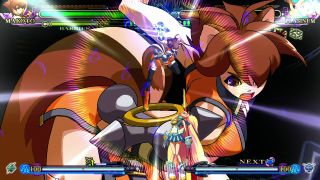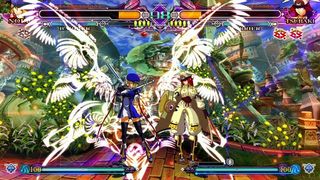The PlayStation Vita doesn’t arrive in North America and Europe for another two months, but we’re way too excited and impatient to wait that long. Thanks to the earlier Japanese launch, we’ve already got a system in office and we’re already diving into our most anticipated PS Vita games. Visit GamesRadar all this week for updated hands-on impressions with the full imported versions, but note that these may not be the final versions you play in February.

BlazBlue: Continuum Shift Extend is poised to be the premier handheld fighting game, with a Vita release that's practically identical to the upcoming console version. The roster includes 19 beautifully-animated characters, counting every DLC and unlockable character from previous iterations, plus the sinister newcomer Relius Clover. Add to that some additional balance tweaks and new modes, and it's clear that this is the definitive BlazBlue game.
What is it? As the spiritual successor to Arc System Works' Guilty Gear series, BlazBlue pits anime-tastic characters in one-on-one combat, with an emphasis on flashy combos and unique mechanics for each fighter. The game's hand-drawn, high-res sprites are utterly gorgeous, and for those who care, there's a fairly involved story mode that'll give context to all the extravagant violence. The BlazBlue series became an instant classic in the four-button fighter genre, and Continuum Shift Extend continues its legacy.
What’s new in the PS Vita version? BBCSE includes a new character (that'll also be in the console version): Relius Clover, master puppeteer and Carl Clover's evil dad. His playstyle is similar to Carl's, making use of his player-controlled living mannequin Ignis to mix up his opponent and extend his combos. In contrast to Carl's knight-themed attacks, Reilus' moves make use of giant mechanical fists to wallop his enemies around the screen. It's also got all the modes one expects from a modern fighting game: network play (including cross-platform!), tutorials, challenge modes, and galleries, as well as the new Unlimited Wars mode that makes you run the gamut of increasingly-tough opponents.

How do the PS Vita controls work? The new-fangled Vita controls offer a few options: you can either set the touchpad to act as a button combination of your choosing, or you can take a shot at controlling the game entirely via touch. Good luck with the latter, because the button and direction hotspots are configured like a stack of towels instead of a d-pad or joystick, playing with the touchpad can only amount to button-mashing sans buttons. It's just as well: fighting games this technical demand precise controls that touch-screens can't yet offer.
The best parts so far: The graphics are, in a word, astounding, with characters moving fluidly and nary a hint of slowdown. The visuals are so crisp that discerning if a screenshot was taken from the Vita or PS3 version would be nigh impossible. Relius seems like an experts-only fighter, given the complexity of his dual-character playstyle, but it's nice finally having the characters all in one place (including office favorite, Platinum the Trinity). Top it all off with speedy load times and the aforementioned story campaign, and you've got what could be the best portable, one-on-one fighting game of all time.
The not-so great parts: Nothing's worse than suffering a wicked thumb cramp during an intense match. Prolonged play with the mini-analog stick will be murder on your ligaments – luckily, the d-pad is much more comfortable and executes the desired inputs 99% of the time. The touchpad controls feel like an afterthought, though we doubt anyone would prefer them over the classic four-button configuration.
When can you play it for yourself? Aksys has the game slated for February 14th launch date via PSN, so you can have it downloaded and ready to rock as soon as you pick up your Vita. Look for our full review at release.

